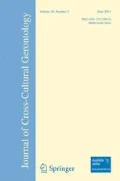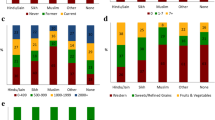Abstract
Research has shown that religion is associated with a wide range of health behaviors among adults of all ages. Although there is strong support for religion’s influence on behaviors such as drinking and smoking, less is known about the possible relationship between religion and the use of preventive health services. This relationship may be particularly important in Mexico, a country with high levels of religiousness and low levels of preventive service utilization. The current study uses a nationally representative sample of middle-aged and older adults in Mexico (n = 9,890) to test the association between three facets of religion and three preventive services aimed at detecting chronic conditions or underlying risk factors. The findings show that religious salience is significantly related to the use of blood pressure and cholesterol screenings, even after controlling for a variety of social, demographic, and health-related factors. In addition, attending religious services and participating in religious activities are both positively associated with blood pressure and diabetes screening. This type of research adds to our knowledge of the determinants of preventive service utilization, as well as to the burgeoning literature on religion and health. Furthermore, because the vast majority of research in this field takes place in more developed and Westernized countries, such as the US and Western Europe, analyzing this relationship in a sample of older Mexicans is critical for providing the field with a more comparative orientation.
Similar content being viewed by others
References
Arredondo, E. M., Elder, J. P., Ayala, G. X., Campbell, N. R., & Baquero, B. (2005). Is church attendance associated with Latinas’ health practices and self-reported health? American Journal of Health Behavior, 29(6), 502–511.
Barr, J. K., Reisine, S., Wang, Y., Holmboe, E. F., Cohen, K. L., Van Hoof, T. J., et al. (2001). Factors influencing mammography use among women in medicare managed care. Health Care Financing Review, 22(4), 49–61.
Benjamins, M. R. (2005). Social determinants of preventive service utilization: How religion influences the use of cholesterol screening in older adults. Research on Aging, 27(4), 475–497.
Benjamins, M. R. (2006a). Religious influences on female preventive service utilization in a nationally representative sample of older women. Journal of Behavioral Medicine, 29(1), 1–16.
Benjamins, M. R. (2006b). Religious influences on trust in physicians and the health care system. International Journal of Psychiatry in Medicine, 36(1), 69–83.
Benjamins, M. R., & Brown, C. (2003). Religion and preventative health care utilization among the elderly. Social Science and Medicine, 58, 109–118.
Bradley, D. E. (1995). Religious involvement and social resources: Evidence from the data set Americans changing lives. Journal for the Scientific Study of Religion, 34, 259–267.
Camp, R. A. (2000). The cross in the polling booth: Religion, politics, and the laity in Mexico. Latin America Research Review, 69–99.
Central Intelligence Agency (CIA). (2004). The world fact book. Retrieved from: http://www.cia.gov/cia/publications/factbook/index.html. Retrieved on: September 15, 2004.
Drociuk, D. (1999). Reasons reported by medicare beneficiaries for not receiving influenza and pneumococcal vaccinations—United States, 1996. Morbidity and Mortality Weekly Report, 48(39), 556.
Ellison, C. G., & George, L. K. (1994). Religious involvement, social ties, and social support in a southeastern community. Journal for the Scientific Study of Religion, 33(1), 46–61.
Ellison, C. G., & Levin, J. S. (1998). The religion–health connection: Evidence, theory, and future directions. Health Education & Behavior, 25(6), 700–720.
Fox, S. A., Pitkin, K., Paul, C., Carson, S., & Duan, N. (1998). Breast cancer screening adherence: Does church attendance matter? Health Education & Behavior, 25(6), 742–758.
Gillum, R. F. (2005). Frequency of attendance at religious services and cigarette smoking in American women and men: The third national health and nutrition examination survey. Preventive Medicine, 41, 607–613.
Glosser, G., Wolfe, N., Albert, M. L., Lavine, L., Steele, J. C., Calne, D. B., et al. (1993). Cross-cultural cognitive examination: Validation of a dementia screening instrument for neuroepidemiological research. Journal of the American Geriatric Society, 41, 931–939.
Health Ministries Association, Inc. Retrieved on: October 11, 2004. Retrieved from: http://www.hmassoc.org/index.html. 2004.
Hill, T. D., Angel, J. L., Ellison, C. G., & Angel, R. G. (2005). Religious attendance and mortality: An 8-year follow-up of older Mexican Americans. Journals of Gerontology, 60(2), 102–109.
Hill, T. D., Burdette, A. M., Angel, J. L., & Angel, R. J. (2006). Religious attendance and cognitive functioning among older Mexican Americans. Journals of Gerontology, 61(1), P3–P9.
Hill, T. D., Burdette, A. M., Ellison, C. G., & Musick, M. A. (2006). Religious attendance and the health behaviors of Texas adults. Preventive Medicine, 42, 309–312.
Hummer, R. A., Rogers, R. G., Nam, C. B., & Ellison, C. G. (1999). Religious involvement and U.S. adult mortality. Demography, 36(2), 273–285.
Hurd, M. (1989). The economic status of the elderly. Science, 244, 659–664.
International Diabetes Foundation (IDF). (2004). Diabetes prevalence. Retrieved from: http://www.idf.org/e-atlas/home/index.cfm?node=412. Retrieved on: September 13, 2004.
Kirkman-Liff, B., & Kronenfeld, J. J. (1992). Access to cancer screening services for women. American Journal of Public Health, 82(5), 733–735.
Koenig, H. G. (1998). Handbook of religion and mental health. San Diego, CA: Academic.
Koenig, H. G., McCullough, M., & Larson, D. (2001). The handbook of religion and health. New York: Oxford University Press.
Koenig, H. G., Shelp, F., Goli, V., Cohen, H. J., & Blazer, D. G. (1989). Survival and health-care utilization in elderly medical inpatients with major depression. Journal of the American Geriatrics Society, 5(2), 123–131.
Levin, J. S., & Markides, K. S. (1985). Religion and health in Mexican Americans. Journal of Religion and Health, 24(1), 60–69.
Levin, J. S., Markides, K. S., & Ray, L. A. (1996). Religious attendance and psychological well-being in Mexican Americans: A panel analysis of three-generations data. Gerontologist, 36(4), 454–463.
McCullough, M. E., Larson, D. B., Hoyt, W. T., Koenig, H. G., & Thoresen, C. (2000). Religious involvement and mortality: A meta-analytic review. Health Psychology, 19(3), 211–222.
Mejia, S., Miguel, A., Gutierrez, L. M., Villa, A. R., & Ostrosky-Solis, F. (2006). Comparative analysis of cognitive impairment among Mexicans and Spanish-speaking immigrant’s elders. Journal of Aging and Health, 18(2), 292–314.
Mexican Health and Aging Study (MHAS) website. (2004). MHAS project overview. Retrieved from: https://www.ssc.upenn.edu/mhas/english/project_ov.htm. Retrieved on: September 25, 2004.
Miller, A. M., & Champion, V. L. (1993). Mammography in women >50 years of age. Cancer Nursing, 16(4), 260–269.
Miller, S. L., Norcross, W. A., & Bass, R. A. (1980). Breast self-examination in the primary care setting. The Journal of Family Practice, 10(5), 811–815.
Murray, M., & McMillan, C. (1993). Social and behavioral predictors of women’s cancer screening practices in Northern Ireland. Journal of Public Health Medicine, 15(2), 147–153.
Naguib, S. M., Geiser, P. B., & Comstock, G. W. (1968). Responses to a program of screening for cervical cancer. Public Health Reports, 83, 990–998.
Nelson, K., Norris, K., & Mangione, C. M. (2002). Disparities in the diagnosis and pharmacologic treatment of high serum cholesterol by race and ethnicity: Data from the their national health and nutrition examination survey. Archives of Internal Medicine, 162, 929–935.
Reuters. Diabetes now Mexico’s leading cause of death. Retrieved on: September 10, 2004. Retrieved from: http://www.reuters.com. 2004.
Simon, G. E., Ormel, J., VonKorff, M., & Barlow, W. (1995). Health care costs associated with depressive and anxiety disorders in primary care. American Journal of Psychiatry, 152, 352–357.
Sloan, R. P., Bagiella, E., & Powell, T. (1999). Religion, spirituality, and medicine. The Lancet, 353(9153), 664–667.
Smith, J. P., & Kington, R. (1997). Demographic and economic correlates of health in old age. Demography, 34, 159–170.
Tamez, S., & Molina, N. (2000). Reorganizing the health care system in Mexico. In S. Fleury, S. Belmartino, & E. Baris (Eds.), Reshaping health care in Latin America: A comparative analysis of health care reform in Argentina, Brazil, and Mexico. Canada: International Development Research Center.
University of Michigan News and Information Services. (1997). Study of worldwide rates of religiosity, church attendance. News Release, retrieved from: http://www.umich.edu/~newsinfo/Releases/1997/Dec97/r121097a.html. Retrieved on September 15, 2004.
Walsh, E. G., Wu, B., Mitchell, J. B., & Berkmann, L. F. (2003). Cognitive function and acute care utilization. Journals of Gerontology, 58(1), S38–S49.
Yi, J. K. (1994). Factors association with cervical cancer screening behavior among Vietnamese women. Journal of Community Health, 19(3), 189–200.
Yi, J. K. (1998). Acculturation and pap smear screening practices among college-aged Vietnamese women in the United States. Cancer Nursing, 21(5), 335–341.
Author information
Authors and Affiliations
Corresponding author
Rights and permissions
About this article
Cite this article
Benjamins, M.R. Predictors of Preventive Health Care Use Among Middle-aged and Older Adults in Mexico: The Role of Religion. J Cross Cult Gerontol 22, 221–234 (2007). https://doi.org/10.1007/s10823-007-9036-4
Received:
Accepted:
Published:
Issue Date:
DOI: https://doi.org/10.1007/s10823-007-9036-4




